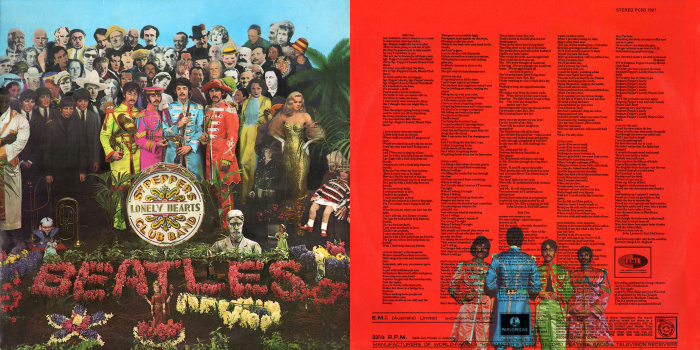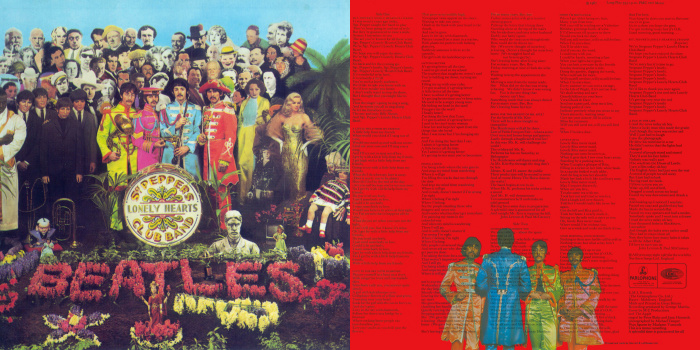SGT. PEPPER'S LONELY HEARTS CLUB BAND
Parlophone PMCO 7027 (MONO) / PCSO 7027 (STEREO)
Parlophone PMCO 7027 (MONO) / PCSO 7027 (STEREO)
LAST UPDATED: 13 JANUARY 2023
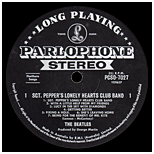
YELLOW/BLACK mono
AU7027M1
10 Aug 1967
AU7027M1
10 Aug 1967
'BANNER' STEREO
AU7027S1
10 Aug 1967
AU7027S1
10 Aug 1967
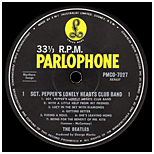
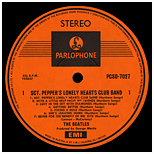
ORANGE 1-BOX A
AU7027S5A
Q3 1969
AU7027S5A
Q3 1969
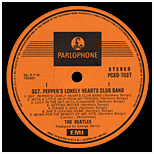
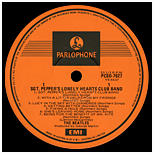
ORANGE 1-BOX B
AU7027S5B
Oct 1978
AU7027S5B
Oct 1978
ORANGE 1-BOX C
AU7027S5C
1979
AU7027S5C
1979
BLACK 1-BOX A
AU7027S6A
Apr 1982
AU7027S6A
Apr 1982
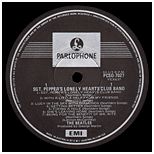
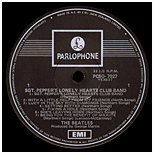
NZ DK GREY 1-BOX A
AU7027S4C
1981
AU7027S4C
1981
BLACK 1-BOX B
AU7027S6B
Jul 1987
AU7027S6B
Jul 1987
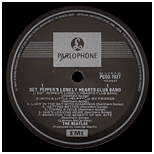
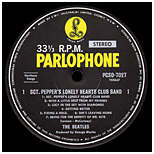
YELLOW/BLACK stereo
AU7027S3
Feb 1969
AU7027S3
Feb 1969
AUDIOPHILE AUDIO-5
AUAUDIO5a
Jul 1983
AUAUDIO5a
Jul 1983
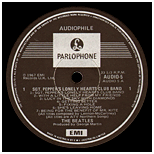
GENERAL ALBUM INFORMATION
In early May 1967, EMI UK despatched 50,000 sleeves to EMI (Australia) plus an indeterminate number of sleeves destined for HMV NZ (but anecdotally somewhere around 5,000). EMI (Australia) had decided to import UK sleeves as the cost of making them locally was simply too prohibitive.
Due to the heightening tensions in the Middle East, the ship transporting the sleeves was redirected around the Cape Of Good Hope, adding an extra 18 or so days to the travel time. This is why the album was not released here in June, which was EMI's original plan (the intention was for Sgt Pepper's to be the first album released worldwide on the same day, but that plan was scuttled when logistics proved it impossible, notwithstanding EMI UK deciding to jump their own gun!).
For whatever reason, HMV NZ decided to forfeit their sleeves and produce their own. Most likely New Zealand's tight import restrictions played a part there. In any event, their sleeves ended up in Australia.
The shipping delay meant that the album did not get to reviewers until the end of July, although, of course, some reviewers already had UK copies in their possession. Meanwhile, Northern Songs—the local publisher for all tracks—instructed the Australian Performing Rights Association to restrict performance of all twelve tracks until mid-July. Restriction culminated with a national promotion by EMI (Australia) called "Beatles week", commencing 31 July, where the album was promoted by dealer displays and nationwide TV, radio and press competitions.
Despite press announcements of a 28 July release, official EMI documentation lists 10 August as the release date.
A few months later, EMI (Australia) requested more sleeves as they had almost exhausted the initial allocation. A second batch was duly despatched and by February 1968, the album had sold 80,000 copies locally, all in UK-sleeves. This second batch seems to be the one that contained a number of German candy-striped inner sleeves, but that's based on available evidence/research/observation. These sleeves lasted into 1969, although there may have been another subsequent shipment; EMI documentation is a bit ambiguous. When stereo sleeves ran out in February 1969, EMI (Australia) started using up excess mono sleeves before introducing their own locally-made (single) sleeve in December 1969 - mouseover the above sleeve image to see the first Australian sleeve. As always though, due to the nature of warehousing, both types of sleeves were used in parallel into early 1970.
Many Australian copies have what's known as a 'widespine' sleeve (with "Patents Pending" text on the rear). While the 'widespine' sleeve is uncommon in the UK—and therefore highly-prized—it's the most common variation found in Australia. Collectors will spend hundreds of pounds to secure a UK widespine, yet one can be had here in Australia for as little as AU$40 (less than 20 GBP).
The album made the singles charts in Perth and Go-Set (nationally compiled), reaching number 12 (over nine weeks) and number 40 (over two weeks) respectively.
1983 AUDIOPHILE PRESSING
This release demands its own page! For more information please visit the "Audiophile Pressing" page and the "30ips Production Master Tape" page.
1987 RED VINYL EDITION
In 1987, coinciding with both the 20th Anniversary of the album's release and its first release on Compact Disc, EMI (Australia) decided to issue a limited edition pressed with red vinyl. As EMI (Australia) did not have the wherewithal to press coloured vinyl, they turned to Festival Records. Festival Records was Australia's oldest and largest independent record label, formed in Sydney in October 1952. It had been dabbling with 12" coloured vinyl and picture discs since 1977.
The task of mastering was handed to Warren Barnett, Festival Records mastering engineer and huge Beatles fan, who incidentally had cut his teeth on Beatles solo records back in 1973/4 when he worked at EMI (Australia). Warren created new half-speed masters from the same 30ips tapes that Don Bartley had used for the 1983 Audiophile release. For more information about the tapes used for this release, please visit the "30ips Production Master Tape" page.
Multiple stampers were created and numbered - the "Matrix Information" table above lists all the stamper variations.
Festival Records pressed just over 9,000 copies of Sgt Pepper's on red vinyl (although early copies were more pink than red!). Copies were pressed with standard EMI labels and were housed in standard EMI single sleeves, although, commencing in July—midway through the red vinyl press run—EMI (Australia) finally introduced a locally-made gatefold sleeve, with insert. This sleeve remained in use until EMI (Australia) ceased pressing vinyl in late 1990. Evidence suggests that the gatefold sleeves may have been ready by the 1 June release date, but in typical fashion EMI (Australia) wanted to use up all existing single sleeves first. On Countdown's 'Humdrum' segment, broadcast on 31 May 1987, reviewer Molly Meldrum clearly shows a single sleeve but with an insert. Perhaps he was afforded a 'special' copy? Although some single sleeve production copies did include the insert.
A sticker stating "SPECIAL LIMITED EDITION IN COLOURED VINYL" was affixed to the front cover of each copy. At least three sticker variations exist.
The mothers/stampers continued to be used by EMI (Australia) after the coloured vinyl run was completed, although at some point they reverted side 1 back to Otto's 1982 -2 cut. At the end of 1988 they introduced new digital remasters, made 12/13 November by Allan Parsons.
Sonically, the Festival masters sound every bit as good as the AUDIOPHILE masters, although, as always, it depends on personal preference. The author finds the AUDIOPHILE pressing to have fuller bass, perhaps due to the freedom that Don was given to EQ to taste. It's not known whether Warren had the same freedom, but, if not, then arguably the Festival masters sound 'truer' to the production master tapes.
In any event, with copies of the latter selling for ~$100 (and later black vinyl copies significantly less!) rather than ~$2,000, it has rightly earned the reputation as the 'poor man's audiophile version'.
Due to the heightening tensions in the Middle East, the ship transporting the sleeves was redirected around the Cape Of Good Hope, adding an extra 18 or so days to the travel time. This is why the album was not released here in June, which was EMI's original plan (the intention was for Sgt Pepper's to be the first album released worldwide on the same day, but that plan was scuttled when logistics proved it impossible, notwithstanding EMI UK deciding to jump their own gun!).
For whatever reason, HMV NZ decided to forfeit their sleeves and produce their own. Most likely New Zealand's tight import restrictions played a part there. In any event, their sleeves ended up in Australia.
The shipping delay meant that the album did not get to reviewers until the end of July, although, of course, some reviewers already had UK copies in their possession. Meanwhile, Northern Songs—the local publisher for all tracks—instructed the Australian Performing Rights Association to restrict performance of all twelve tracks until mid-July. Restriction culminated with a national promotion by EMI (Australia) called "Beatles week", commencing 31 July, where the album was promoted by dealer displays and nationwide TV, radio and press competitions.
Despite press announcements of a 28 July release, official EMI documentation lists 10 August as the release date.
A few months later, EMI (Australia) requested more sleeves as they had almost exhausted the initial allocation. A second batch was duly despatched and by February 1968, the album had sold 80,000 copies locally, all in UK-sleeves. This second batch seems to be the one that contained a number of German candy-striped inner sleeves, but that's based on available evidence/research/observation. These sleeves lasted into 1969, although there may have been another subsequent shipment; EMI documentation is a bit ambiguous. When stereo sleeves ran out in February 1969, EMI (Australia) started using up excess mono sleeves before introducing their own locally-made (single) sleeve in December 1969 - mouseover the above sleeve image to see the first Australian sleeve. As always though, due to the nature of warehousing, both types of sleeves were used in parallel into early 1970.
Many Australian copies have what's known as a 'widespine' sleeve (with "Patents Pending" text on the rear). While the 'widespine' sleeve is uncommon in the UK—and therefore highly-prized—it's the most common variation found in Australia. Collectors will spend hundreds of pounds to secure a UK widespine, yet one can be had here in Australia for as little as AU$40 (less than 20 GBP).
The album made the singles charts in Perth and Go-Set (nationally compiled), reaching number 12 (over nine weeks) and number 40 (over two weeks) respectively.
1983 AUDIOPHILE PRESSING
This release demands its own page! For more information please visit the "Audiophile Pressing" page and the "30ips Production Master Tape" page.
1987 RED VINYL EDITION
In 1987, coinciding with both the 20th Anniversary of the album's release and its first release on Compact Disc, EMI (Australia) decided to issue a limited edition pressed with red vinyl. As EMI (Australia) did not have the wherewithal to press coloured vinyl, they turned to Festival Records. Festival Records was Australia's oldest and largest independent record label, formed in Sydney in October 1952. It had been dabbling with 12" coloured vinyl and picture discs since 1977.
The task of mastering was handed to Warren Barnett, Festival Records mastering engineer and huge Beatles fan, who incidentally had cut his teeth on Beatles solo records back in 1973/4 when he worked at EMI (Australia). Warren created new half-speed masters from the same 30ips tapes that Don Bartley had used for the 1983 Audiophile release. For more information about the tapes used for this release, please visit the "30ips Production Master Tape" page.
Multiple stampers were created and numbered - the "Matrix Information" table above lists all the stamper variations.
Festival Records pressed just over 9,000 copies of Sgt Pepper's on red vinyl (although early copies were more pink than red!). Copies were pressed with standard EMI labels and were housed in standard EMI single sleeves, although, commencing in July—midway through the red vinyl press run—EMI (Australia) finally introduced a locally-made gatefold sleeve, with insert. This sleeve remained in use until EMI (Australia) ceased pressing vinyl in late 1990. Evidence suggests that the gatefold sleeves may have been ready by the 1 June release date, but in typical fashion EMI (Australia) wanted to use up all existing single sleeves first. On Countdown's 'Humdrum' segment, broadcast on 31 May 1987, reviewer Molly Meldrum clearly shows a single sleeve but with an insert. Perhaps he was afforded a 'special' copy? Although some single sleeve production copies did include the insert.
A sticker stating "SPECIAL LIMITED EDITION IN COLOURED VINYL" was affixed to the front cover of each copy. At least three sticker variations exist.
The mothers/stampers continued to be used by EMI (Australia) after the coloured vinyl run was completed, although at some point they reverted side 1 back to Otto's 1982 -2 cut. At the end of 1988 they introduced new digital remasters, made 12/13 November by Allan Parsons.
Sonically, the Festival masters sound every bit as good as the AUDIOPHILE masters, although, as always, it depends on personal preference. The author finds the AUDIOPHILE pressing to have fuller bass, perhaps due to the freedom that Don was given to EQ to taste. It's not known whether Warren had the same freedom, but, if not, then arguably the Festival masters sound 'truer' to the production master tapes.
In any event, with copies of the latter selling for ~$100 (and later black vinyl copies significantly less!) rather than ~$2,000, it has rightly earned the reputation as the 'poor man's audiophile version'.
| FORMAT | RELEASE DATE | SIDE 1 MATRIX | SIDE 2 MATRIX | PARTS |
| MONO | 10 Aug 1967 | XEX 637-1 | XEX 638-1 | UK |
| STEREO | 10 Aug 1967 | YEX 637-1 | YEX 638-1 | UK |
| STEREO | 25 Oct 1982 | YEX 637-1 | YEX 638-2 OR | UK/AU |
| STEREO | 25 Oct 1982 | YEX 637-2 OR | YEX 638-2 OR | AU |
| STEREO | 3 Jul 1983 | AUDIO 5-A -3 DB | AUDIO-5-B DB | AU* |
| STEREO | 1 Jun 1987 | PCSO-7027-A AMX-67841-YEX-638 W2B |
PCSO-7027 AMX-67842 W2C |
AU** |
| STEREO | 1 Jun 1987 | PCSO-7027-A AMX-67841-YEX-638 W2B2 |
PCSO-7027 AMX-67842 W2C |
AU** |
| STEREO | 1 Jun 1987 | PCSO-7027-A AMX-67841-YEX-638 W2B2 |
PCSO-7027 AMX-67842 W2C2 |
AU** |
| STEREO | Aug 1987 | PCSO-7027-A AMX-67841-YEX-638 W2B |
PCSO-7027 AMX-67842 W2 |
AU** |
| STEREO | Aug 1987 | PSCO 7027-A AMX-67841 YEX-638 W2B |
PCSO 7027-B1 AMX-67842 YEX-639 W2C |
AU** |
| STEREO | Aug 1987 | PCSO-7027-A AMX-67841-YEX-63 |
PCSO-7027B AMX-67842 W2C YEX 638 |
AU** |
| STEREO | Aug 1987 | YEX 637-2 | PCSO-7027B AMX-67842 W2C YEX 638 |
AU |
| STEREO | 14 Nov 1988 | PCSO 7027 D-A | PCSO 7027 D-B | AU |
| * Masters created for extremely limited 1983 AUDIOPHILE reissue. ** Masters created for 1987 red vinyl reissue; cut at Festival Records by Warren Barnett as EMI did not have the wherewithal to press coloured vinyl. Some audiophiles insist that this pressing is every bit the sonic/aural equal of the 1983 AUDIOPHILE pressing. The mothers continued to be used by EMI (Australia) after the coloured vinyl run was completed, until being replaced by the digital remasters in late 1988. |
||||
MATRIX INFORMATION
Machine Stamped - Hand Written
Machine Stamped - Hand Written
| ORIGIN | CODE | CIRCULATED | SLEEVE DETAILS |
| UK | UK1 | Jul 1967 | Imported UK mono g/fold sleeve; wide spine; "Patents Pending"; cutout sheet and "Fool" inner sleeve |
| UK | UK2 | Jul 1967 | Imported UK stereo sleeve; wide spine; cutout sheet and "Fool" inner sleeve |
| UK | UK3 | 1968 | Imported UK mono sleeve; normal spine; cutout sheet and "Fool" inner sleeve |
| UK | UK4 | 1968 | Imported UK stereo sleeve; normal spine; cutout sheet and "Fool" inner sleeve |
| UK | UK5 | Mar 1969 | Same as UK4, but with black/white STEREO sticker affixed top left |
| AUST | AU1 | Dec 1969 | Single-pocket; no cutout sheet or "Fool" inner sleeve; early sleeves laminated, then unlaminated |
| AUST | AU2 | 1979 | Similar to AU1 but with different footer text on rear sleeve |
| AUST | AU3 | Jul 1987 | G/fold with cutout sheet. Rear-cover footer manufacture credits at right |
| AUST | AU4 | Nov 1988 | G/fold with cutout sheet; "DIGITALLY REMASTERED" footer on rear cover; rear-cover footer manufacture credits at left, with larger 'EMI' logo than AU3 |
SLEEVE INFORMATION
